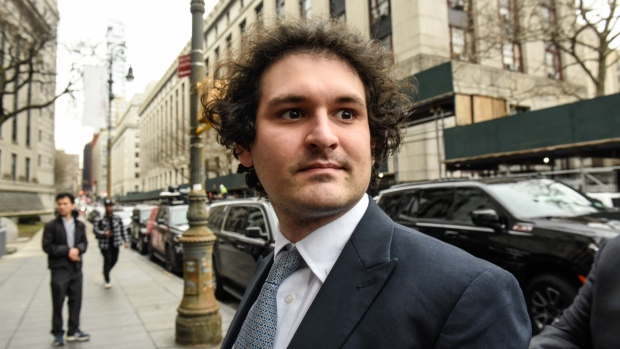Feb 17, 2024
Bahamas Bank Deltec Accused of Giving Bankman-Fried ‘Secret’ Credit to Buy Tether
, Bloomberg News

(Bloomberg) -- It was one of the remaining puzzles after Sam Bankman-Fried’s conviction on fraud charges: what was the relationship between the one-time crypto billionaire, a Bahamas bank whose chairman created the cartoon Inspector Gadget, and cryptocurrency Tether?
Text messages, a declaration from Bankman-Fried’s former colleague and ex-girlfriend Caroline Ellison, and other documents published as part of a lawsuit filed against alleged enablers of his scheme suggest a tighter web of connections than previously known.
The lawsuit alleges that Bankman-Fried’s hedge fund Alameda Research fueled the growth of Tether using in part a secret short-term line of credit worth billions of dollars from the Bahamas-based Deltec Bank & Trust Ltd. Tether is not being sued in the case.
It also claims that Deltec helped Bankman-Fried misappropriate customer funds by transferring them between accounts for his exchange FTX and Alameda. Deltec had more than enough reason to be suspicious of the transfers, according to the lawsuit.
Desiree Moore, a lawyer for Deltec at Venable LLP in Chicago, said the bank and its chairman, Jean Chalopin, had no knowledge of FTX’s misconduct until it was made public.
“The new allegations rely heavily on unsubstantiated statements by individuals who we understand are settling their lawsuits with plaintiffs in exchange for providing the information,” she said.
Stuart Hoegner, a lawyer for Tether, didn’t immediately respond to requests for comment outside of regular business hours.
The documents were filed on Friday in a Florida federal court, part of a case brought by lawyers for victims of Bankman-Fried’s fraud, who are seeking to recover damages from alleged enablers including Deltec. The lawyers said in the filing that Ellison cooperated with them as part of settlement negotiations and turned over 7,000 pages of Telegram chats.
Tether is what’s called a stablecoin, because it’s supposed to be backed by real assets held in a bank. Brock Pierce, a former child actor from The Mighty Ducks, is a co-founder of Tether but is no longer involved with the stablecoin.
Its total assets were $97 billion against $91.6 billion in liabilities as of December. Skeptics have long questioned how it grew so large and whether it really had the money it claimed, though last month Cantor Fitzgerald LP chief Howard Lutnick said that Tether’s assets are real and his investment bank holds most of them.
Read more: Why Stablecoins Still Worry the Fed as They Try to Go Mainstream
Chalopin is the creator of Inspector Gadget. He is neighbors in the Bahamas with Giancarlo Devasini, the Italian former plastic surgeon who’s Tether’s chief financial officer and de facto chief.
Bankman-Fried’s companies started opening accounts at Deltec in 2018, in part to gain easier access to Tether. Alameda would simply transfer money from its account at Deltec to Tether’s to create tokens, according to the lawsuit.
When crypto was booming, in 2020 and 2021, Bankman-Fried’s fund helped create billions of dollars of Tether tokens, according to the lawsuit. Alameda would receive them days in advance of actually paying for them and would sell them at a profit, the lawyers said.
Tether has consistently denied any manipulation of its stablecoin. After FTX failed, the company put out a statement saying the collapse posed no risk to Tether because Alameda always paid for its tokens with US dollars.
Read more: Biggest Stablecoin Firm Tether Is Becoming a Major Bitcoin Miner
Starting in 2021, Deltec granted Alameda a three-day grace period to pay for the Tethers it was buying, effectively giving the fund a short-term line of credit, according to the lawsuit. The bank didn’t offer the grace period to other customers and a Deltec executive told the Alameda traders to keep it secret, according to the lawsuit. This “secret line of credit” sometimes exceeded $2 billion, the lawsuit said.
This enabled profitable trades for Alameda, because Tether often traded for a tiny bit more than $1 on the market. Alameda would be issued Tether coins which it could sell into the market before it had to pay for them, the lawsuit said. The fund did pay for them later, according to the lawsuit.
“Alameda could create USDT on credit through the unofficial Deltec Line of Credit and sell that USDT for a gain before having to fund the purchase by depositing US Dollars in Tether’s Deltec account,” Ellison said in a declaration that was included in Friday’s filing, referring to the stablecoin by its ticker symbol.
Text messages revealed in the lawsuit suggested that Tether’s Devasini was friendly with Alameda’s traders. They texted one another to celebrate as the stablecoin grew first to $10 billion, then to $20 billion and $30 billion, and quibbled over who was more responsible for the group’s success.
“We are a big family…we will conquer the world,” Devasini wrote to Alameda traders in 2020.
The lawsuit also alleged that Deltec received deposits from FTX’s customers, and even knowing that those were customer funds, improperly sent them to Alameda. Deltec exempted Alameda from some rules and when crypto crashed, prioritized its withdrawals above those of other customers, according to the lawsuit.
The lawsuit alleged that FTX also came to Deltec’s aid. In October 2021, after the bank failed to raise loan capital elsewhere, its parent Deltec International Group received a $50 million loan from an entity controlled by FTX executive Ryan Salame, the case claimed. Alameda also invested in Moonstone Bank, a tiny lender in Farmington, Washington, that Chalopin controlled.
FTX collapsed in November 2022. Bankman-Fried, its 31-year-old founder who was once worth more than $20 billion, was found guilty of seven counts of fraud and conspiracy and faces the possibility of decades in prison. His sentencing is scheduled for next month.
Bankman-Fried Trial Revives Conjecture on Alameda’s Tether Ties
©2024 Bloomberg L.P.





